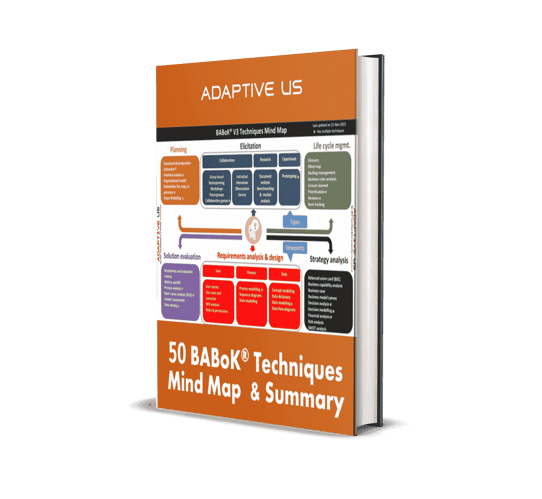How to Choose the Right Business Analysis Approach
Welcome to our blog post on planning the business analysis approach for a project! As a business analyst, choosing the correct business analysis approach is crucial in ensuring the success of the project. Whether you opt for the traditional waterfall approach or embrace the dynamic nature of agile methodologies, understanding their implications and benefits will help you make an informed decision.
In this article, we'll explore both approaches and explain why selecting the appropriate approach is important. We'll also delve into the various factors influencing your business analysis planning approaches and discuss how activities and deliverables play a vital role in achieving project objectives.
So let's dive in and equip ourselves with valuable insights into navigating through this knowledge area of business analysis tasks!
Choosing the Business Analysis Approach
The approach provides a high-level road map regarding how business analysis is conducted. It affects business analysis timing, deliverables, resource allocation.
There are two main approaches to consider: waterfall and agile.
The waterfall approach follows a linear and sequential process, where each phase must be completed before moving on to the next. This method works well for projects with clearly defined requirements and stable scope. It allows for thorough planning upfront, reducing uncertainties later on.
On the other hand, agile methodologies embrace flexibility and adaptability. They prioritize collaboration, iterative development, and continuous feedback from stakeholders. Agile methods are ideal when requirements may change or evolve throughout the project lifecycle.
When deciding which approach to choose, it's essential to consider factors such as project size, complexity, timeline constraints, stakeholder preferences, and team capabilities. Each methodology has strengths and weaknesses that should align with your project needs.
By selecting an appropriate methodology early on in your planning process, you will set clear expectations for stakeholders regarding deliverables and timelines. This will help ensure efficient communication between all parties involved throughout the project lifecycle.
Remember that there is no one-size-fits-all solution when choosing a business analysis approach. Evaluate your unique project requirements carefully before making a decision – this will ultimately save time, effort, and resources down the line!
Waterfall approach
The waterfall approach is a traditional project management methodology that follows a sequential, linear process. It is characterized by its structured and rigid nature, where each project phase must be completed before moving on to the next one.
During a large waterfall project, distinct phases need to be accomplished systematically. These include requirements gathering, system design, implementation, testing, and deployment. Each phase has clear deliverables and milestones to be met before progressing.
One of the advantages of the waterfall approach is its predictability and stability. Since it follows a strict plan with predefined objectives and timelines, it allows for better tracking of progress and resource allocation.
However, this methodology also comes with limitations. Its inflexibility can make it challenging to accommodate changes or adapt to evolving requirements during the project lifecycle. Additionally, issues may arise if stakeholders have difficulty visualizing the final product until late in the development process.
While the waterfall approach provides structure and clarity for business analysis tasks within a project's knowledge area, careful consideration should be given to determine if it aligns with your specific needs before adopting it as your chosen methodology.
What happens during a large waterfall?
What happens during a large waterfall project? In this traditional methodology, the project progresses through sequential phases, with each phase building upon the previous one. It starts with detailed planning and requirements gathering, followed by design, implementation, testing, and finally, deployment.
During the planning phase of a waterfall project, extensive documentation is created to outline all aspects of the project. This includes defining the scope, objectives, deliverables, timelines, and resource requirements. Clear milestones are established to track progress throughout the project.
Once planning is complete and requirements are gathered in detail, during analysis phase begins. Business analysts work closely with stakeholders to identify their needs and document them thoroughly using techniques like interviews or workshops. These requirements serve as a foundation for subsequent stages of development.
The design phase focuses on creating blueprints for building the system. Detailed technical specifications are prepared based on previously defined functional requirements from business analysts.
Next comes implementation, where developers start coding according to designs and specifications created earlier in order to build the product or system being developed.
Testing is an integral part of any software development process. During this stage in waterfall projects, thorough testing is done before moving forward, ensuring that all functionalities work as expected without any issues or bugs
Finally comes deployment. When everything has been tested properly, it moves towards actual release, which involves transferring the finished product/system into the production environment, making it available for users/stakeholders
In conclusion,
Following these sequential steps in large waterfall projects ensure a clear structure throughout every aspect of the development process, leading to successful completion within budget constraints.
What is the Agile approach?
Agile is a popular methodology in business analysis that emphasizes flexibility, collaboration, and iterative development. Unlike the traditional waterfall approach, which follows a linear sequence of activities, Agile focuses on delivering small increments of value through frequent iterations.
In an Agile project, the requirements are not set in stone at the beginning; instead, they evolve and adapt as the project progresses. This allows for quicker feedback loops and enables teams to respond to changing market needs more effectively.
One key aspect of Agile is its emphasis on cross-functional teams working closely together. These teams include representatives from various disciplines, such as developers, testers, designers, and business analysts. By promoting collaboration and open communication within these teams, Agile fosters a greater understanding of user needs and ensures that everyone's expertise contributes to delivering high-quality solutions.
Another characteristic of Agile is its reliance on regular meetings or "ceremonies" to facilitate cooperation and transparency among team members. Examples include daily stand-up meetings where team members discuss progress and blockers, sprint planning sessions where work for each iteration is defined collaboratively, and retrospective meetings where lessons learned are shared.
Adopting an agile approach can bring multiple benefits, such as increased customer satisfaction due to the early delivery of valuable features; improved adaptability to changes in requirements or priorities; enhanced team morale through empowerment and ownership; better visibility into project progress through regular demonstrations; higher quality deliverables due to continuous integration testing; reduced risk by addressing issues earlier in the process.
In conclusion,
The agile approach offers businesses a flexible framework for managing projects while keeping pace with evolving market demands. By embracing agility principles like iterative development cycles and cross-functional teamwork, organizations can improve their responsiveness while ensuring successful outcomes for their projects.
Factors affecting the business analysis planning approach
Several factors must be considered when planning the business analysis approach for a project. One of the key factors is the nature and complexity of the project itself. Different projects require different approaches, so assessing the methodology best suits your specific needs is essential.
Another factor that can impact the planning approach is the availability of resources. This includes not only financial resources but also human resources. It's crucial to clearly understand who will be involved in the business analysis process and their level of expertise.
The timeline and deadline for completing the project also play a significant role in determining which planning approach to adopt. If you have strict deadlines, an Agile approach might be more suitable as it allows for flexibility and quick iterations.
Additionally, stakeholder involvement can greatly influence how you plan your business analysis activities. Understanding their expectations and requirements will help you tailor your approach accordingly.
Organizational culture and preferences should not be overlooked when deciding on a methodology. Some organizations may already have established processes or preferred methodologies, while others may be open to exploring new approaches.
Multiple factors need to be considered when planning the business analysis approach for a project. By carefully considering these factors - such as project nature, available resources, timelines, stakeholder involvement, and organizational culture - you can make an informed decision about which methodology will best suit your needs.
Involvement of Stakeholders
One crucial aspect of planning the business analysis approach is identifying the involvement of stakeholders. These individuals or groups have a vested interest in the project and can significantly impact its success. A business analyst can ensure that all relevant parties are included throughout the process by understanding their needs, expectations, and concerns.
To identify stakeholders, it's important to conduct thorough research and analysis. This involves gathering information about key individuals or groups who may be affected by or have an influence on the project. It also requires considering both internal and external stakeholders – from employees and management to customers, suppliers, regulators, and even competitors.
Once identified, stakeholders must be categorized based on their level of influence and interest in the project. Some may be highly influential decision-makers with a high level of interest in ensuring project success. Others may have minimal influence but must be kept informed for transparency.
By involving stakeholders early on in the planning phase, businesses can gain valuable insights into requirements, constraints, risks, and priorities. This collaborative approach helps build trust among stakeholders while ensuring that their perspectives are considered when making critical decisions.
Effective stakeholder identification fosters better communication and improves overall project outcomes by proactively managing challenges before they escalate into more significant issues. Therefore Business analysts play a vital role in engaging with various stakeholder groups throughout different stages of a project to ensure alignment between business objectives and stakeholder expectations.
Conclusion
In the world of business analysis, choosing the right methodology for your project is crucial. Whether you opt for the traditional waterfall approach or embrace Agile's flexibility, understanding each method's benefits and limitations will greatly impact your success.
By carefully planning your business analysis approach, you can ensure that all stakeholders are engaged and informed throughout every step of the process. This includes identifying deliverables, utilizing activities to produce those deliverables, and involving stakeholders in decision-making.
A well-planned business analysis approach will lead to better project outcomes. It will help uncover key insights into requirements and facilitate effective communication among team members. By considering factors such as project complexity, stakeholder preferences, and organizational culture when selecting a methodology, you can set yourself up for success from day one.
So take the time to plan your business analysis approach thoughtfully. Consider knowledge areas and specific tasks related to business analysis while keeping in mind how each methodology aligns with your goals. With careful planning and execution, you'll be on track to deliver successful projects that meet both client expectations and organizational objectives.
Remember: The right methodology sets the stage for success!
-----------------------------------------
You May Also Like
These Related Stories

How to Plan BA Governance - 5 Definitive Steps

How to ace IIBA certifications in the very first attempt



No Comments Yet
Let us know what you think